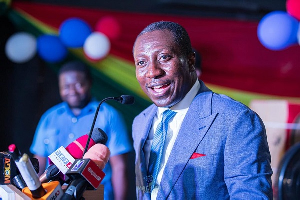By Sydney Casely-Hayford, www.ghananewsmonthly.com
18th August 1955, the Asantene addresses the Confederacy Council that “the Kumawuhene … did not want anything to do with the National Liberation Movement (NLM), which was fighting for the preservation of our traditions and culture. The Kumawuhene believed that a pipe-borne water supply was of more importance than the preservation of our culture” (Austin, Politics in Ghana, 1946-1960, p.291). This statement was made at the height of conflict between the CPP, which encouraged the Brong chiefs to split from and weaken the Asante Kingdom in order to gain political control over Ashanti and the NLM. The chief got his water supply, the CPP’s Krobo Edusei won the Sekyere East constituency vote! The legend of Kum(asi) and Kum(awu) is woven in the establishment of Kumasi as the center of power of Asante, after Komfo Anokye planted two Kum trees in both cities. One lived to provide shelter (asi) the other died (awu). The Brong are closely linked by language and culture to the Ashanti, through Akan chiefdom. This example of political interference was used by the British and the CPP, to whittle down the power base of the NLM within the Ashanti Kingdom from the early 1900s. At the beginning of the nineteenth century the Brong chiefdoms were subject to Kumasi; later they joined with the British against Ashanti and were rewarded after 1901 by being recognized as separate states of a Western Ashanti Province. In 1935 after the Ashanti Confederacy was restored, the Chief Commissioner of the Colony pressured Brong chiefs to rejoin the Confederacy. Of the ten most important states, Banda, Wenchi and Mo joined immediately. Drobo, Dormaa, Berekum joined a few months later; Techiman agreed (under pressure) in April 1936, Abease in October 1938 and Attebubu remained outside the Confederacy. Not all of them were of Brong origion, but they had common grievances against Ashanti.
Then in 1948, Techiman announced its intention of withdrawing from the Confederacy. The claim was based on economic reasons; the right to collect levy payments from nine villages in the valley of the Tano-Subin rivers, which had been transferred by a local Committee of privileges in 1936 to Kumasi. The Techiman chief had fought his case in a long chain of litigation from the Chief Commissioner’s court to the Privy Council in London – and had lost.
So, when in 1948 the chief refused to attend Confederacy Council meetings, Techiman was stripped of its status as a native Authority. However, by 1951, with support from other surrounding chiefs (Dormaa in particular), they formed the Brong-Kyempem federation. Their main reasons were founded on the accusation that the “true Ashanti states” had concentrated the benefits of the Confederacy on themselves at Brong expense.
Initially, the CPP disapproved of the Brong-Kyempem federation stating that it was opposed to tribalism. But pressure from Dormaa and Tehiman was difficult to resist and the CPP’s own desire in tandem with British needs to dilute Ashanti power overtook loftier ideologies.
On 25th March 1955, Nkrumah informed the National Assembly that its government was considering the “possibility of setting up a Brong-Kyempem traditional Council”. Among other issues, “the case for the establishment of two administrative regions for Ashanti”. In December of 1955, the government enacted a State Council (Ashanti) Amendment Ordinance, which enabled subordinate chiefs in the Brong area and Ashanti proper, to appeal to the Governor against decisions of the Kumasi and Ashanti Councils. In effect, Ashanti no had no power of discipline against its rebellious subordinates.
CPP party leaders urged patience in Brong until the Ashanti problem had been dealt with and they would have their reward. This they did and loyal they remained, until in 1958 the CPP government rewarded them with a separate Brong region with its own administrative headquarters, Regional Commissioner and House of Chiefs, carved out of the western and northern districts of Ashanti. The CPP acted out of political expediency and their need for support in the looming elections in 1956 for self-government. The decision to secede from Ashanti had not been unanimous. Wenchi and Berekum chiefs among a few others remained loyal to the Golden Stool.
Now, roll forward to 2010 and the same old rivalries are still there. You can understand Asanteman’s reaction to the “alleged kidnapping” and torture of his vassal in Tuobodom and the again “alleged statement” by the Techimanhene that “his people are now in power”, meaning the NDC party (now evolving into a CPP party) are there to protect him; as the CPP did in the colonial days?
Dismayingly, we have not learnt from the lessons of the past. State interference in chieftaincy disputes of this nature present conspiracy theorists with gleeful nights. Why has the NDC government so hastily sent a “high powered” delegation to Asanteman? Can they see an opportunity to weaken the “voting world bank” of the NPP party and thus self-perpetuate in 2012? Our constitution supports independence and preservation of traditional rule. It also charges the Chief Executive not to mix our religion with our politics. British indirect rule changed the course of our lives in the Colony. The CPP’s nationalist fervor destabilised traditional rule, usurping hierarchical allegiance through state legislation. It is when we disguise political intentions as a need to secure our state that we create protracted boundary issues and destroy our time-tested traditions and culture.
Opinions of Thursday, 18 March 2010
Columnist: Casely-Hayford, Sydney


















